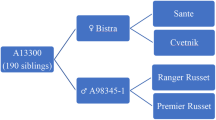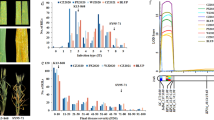Abstract
Cotton (Gossypium spp.) is an economically important crop which provides a significant source of fiber, animal feed, and food oil worldwide. Bacterial blight (BB), caused by Xanthomonas citri pv. malvacearum (Xcm), infects the aerial part of the cotton plant at all stages and can cause a significant loss in yield and fiber quality. In this study, 288 Upland (G. hirsutum) and 8 Pima (G. barbadense) commercial transgenic cultivars and elite breeding lines were divided into 10 replicated tests and evaluated for BB resistance using the toothpick scratching method in the greenhouse in 2016–2017. Five Upland and four Pima genotypes were used as resistant and susceptible controls, respectively. The percentage of susceptible plants with water-soaking symptoms was calculated on a replication basis for each genotype. While all the commercial Pima cultivars tested were susceptible, 21 commercial Upland cultivars were resistant to Xcm race 18. A total of 22 elite public breeding lines were resistant, including 11 lines from the University of Arkansas with an active breeding program for BB resistance and 1–4 resistant lines from five other public breeding programs without an active screening component for BB resistance. Of more than 150 breeding lines developed at New Mexico State University, 11 were found to be resistant to BB. Many commercial cultivars and public breeding lines were found to contain various levels of susceptible plants and are therefore heterogeneous in BB resistance. The results suggest that the resistance to Xcm race 18 can be easily bred in breeding without a selection pressure. A pedigree analysis showed that there are likely different sources of BB resistance. The resistant cultivars and lines identified should be a valuable resource to improve BB resistance in cotton breeding.
Similar content being viewed by others
References
Allen TW (2020) Cultivar response to inoculation with Xanthomonas citri subsp. malvacearum in Mississippi in 2019. In: Proceedings of the Beltwide cotton conference. Austin, TX, January 8–10, 2020, pp 80–83
Bechere E, Manning R (2018) Registration of cotton germplasm USDA MD 16-1 and USDA MD 16-2 with enhanced lint yield and fiber quality. J Plant Reg 12:241–245
Bird LS (1982) The MAR (multi-adversity resistance) system for genetic improvement of cotton. Plant Dis 66:172–176
Bird LS, Brinkerhoff LA, Davis RG (1981) Bacterial blight. In: Watkins GM (ed) Compendium of cotton diseases. APS Press, St. Paul, pp 25–28
Bourland FM (1997) Registration of ‘H1330’ cotton. Crop Sci 36:813
Bourland FM (2018) Breeding for bacterial blight resistance in cotton. In: Proceedings of the Beltwide cotton conference, San Antonio, TX, January 3–5, 2018. Natl, Cotton Counc Am, Memphis
Bourland FM, Jones DC (2005) Registration of Arkot 9111 germplasm line of cotton. Crop Sci 45:2127–2128
Bourland FM, Jones DC (2010) Registration of Arkot 9811 and Arkot 9815 germplasm lines of cotton. J Plant Reg 4:232–235
Bourland FM, Jones DC (2011) Registration of Arkot 0015a, Arkot 0015b, and Arkot 0016 germplasm lines of cotton. J Plant Reg 5:379–383
Bourland FM, Jones D (2012a) Registration of ‘UA48’ cotton cultivar. J Plant Reg 6:15–18
Bourland FM, Jones DC (2012b) Registration of ‘UA222’ cotton cultivar. J Plant Reg 6:259–262
Bourland FM, Jones DC (2014) Registration of Arkot 0111, Arkot 0113, and Arkot 0114 germplasm lines of cotton. J Plant Reg 8:68–72
Bourland FM, Jones DC (2020) Registration of ‘UA212ne’, a nectariless cotton cultivar. J Plant Reg 14:266–272
Brinkerhoff LA (1970) Variation in Xanthomonas malvacearum and its relation to control. Annu Rev Phytopath 8:85–110
Cantrell RG, Roberts CL, Waddell C (2000) Registration of ‘Acala 1517-99’ cotton. Crop Sci 40:1200–1201
Cox KL, Meng F, Wilkins KE, Li F, Wang P, Booher NJ, Carpenter SCD, Chen LQ, Zheng H, Gao X, Zheng Y, Fei Z, Yu JZ, Isakeit T, Wheeler T, Frommer WB, He P, Bogdanove AJ, Shan L (2017) TAL effector driven induction of a SWEET gene confers susceptibility to bacterial blight of cotton. Nat Commun 8:15588
Cox KL, Babilonia K, Wheeler T, He P, Shan L (2019) Return of old foes—recurrence of bacterial blight and Fusarium wilt of cotton. Curr Opin Plant Biol 50:95–103
Delannoy E, Lyon BR, Marmey P, Jalloul A, Daniel JF, Montillet JL, Essenberg M, Nicole M (2005) Resistance of cotton towards Xanthomonas campestris pv. malvacearum. Ann Rev Phytopath 43:63–82
Dever JK (2000) New cotton varieties from FiberMax: FM 958, FM 966. In: Proceedings of the Beltwide cotton conference, vol 1. National Cotton Council, Memphis, TN, pp 104–106
El-Zik KM, Thaxton PM (1995) Breeding for resistance to bacterial blight of cotton in relation to races of the pathogen. In: Constable G, Forrester N (eds) Challenging the future: proceedings of the world cotton research conference-1, Brisbane Australia, pp 236–241
Hillocks RJ (1992) Bacterial blight. In: Hillocks RJ (ed) Cotton diseases. CAB Int, Wallingford Oxon, pp 39–85
Hussain T, Brinkerhoff LA (1978) Race 18 of the cotton bacterial blight pathogen, Xanthomonas malvacearum, identified in Pakistan in 1977. Plant Dis Rep 62:1085–1087
Hunter RE, Brinkerhoff L, Bird L (1968) Development of a set of upland cotton lines for differentiating races of Xanthomonas malvacearum. Phytopathology 58:830
Innes NL (1983) Bacterial blight of cotton. Biol Rev 58:157–176
Jalloul A, Sayegh M, Champion A, Nicole M (2015) Bacterial blight of cotton. Phytopathol Mediterranea 54:3
Kemerait B, Allen T, Lu S, Rothrock C, Faske T, Woodward J, Wheeler T, Isakeit T, Bart R, Phillips A, Lawrence K, Hagan A, Price P, Mehl H, Dufault N, Kelly H, Nichols R (2017) Identification and management of bacterial blight of cotton. https://www.cottoninc.com/wp-content/uploads/2018/01/Management-of-Bacterial-Blight-of-Cotton.pdf. Accessed 23 Dec 2020
Mahmood T, Hussain T (1993) Comparison of inoculating methods of Xanthomonas campestris pv. malvacearum in cotton cultivars. Sarhad J Agric 9:1–4
Phillips AZ, Berry JC, Wilson MC, Vijayaraghavan A, Burke J, Bunn JI, Allen TW, Wheeler T, Bart RS (2017) Genomics-enabled analysis of the emergent disease cotton bacterial blight. PLoS Genet 13:e1007003
Sanogo S, Zhang J (2016) Resistance sources, resistance screening techniques and disease management for Fusarium wilt in cotton. Euphytica 207:255–271
Smith C, Hague S, Jones D (2011) Registration of ‘Tamcot 73’ Upland cotton cultivar. J Plant Reg 5:273–278
Thaxton PM, El-Zik KM (1993) Methods for screening and identifying resistance to the bacterial blight pathogen in cotton in the MAR program. In: Proceedings of the Beltwide cotton conference, New Orleans, LA. 10–14, Jan. 1993. Natl Cotton Counc Am, Memphis, TN, pp 211–212
Thaxton PM, El-Zik KM (2001) Bacterial blight. In: Kirkpatrick TL, Rockroth CS (eds) Compendium of cotton diseases, 2nd edn. Am Phytopathol Soc, St. Paul, pp 34–35
Verma JP (1986) Bacterial blight of cotton. CRC Press, Boca Raton
Wallace TP, El-Zik KM (1989) Inheritance of resistance in three cotton cultivars to the HVI isolate of bacterial blight. Crop Sci 29:1114–1119
Wheeler TA (2011) Bacterial blight ratings for varieties. http://agrilife.org/lubbock/files/2011/10/bactblightratings.pdf. Accessed 23 Dec 2020
Wheeler T (2018) Bacterial blight on cotton. In: Beltwide cotton conference, San Antonio, TX, January 3–5, 2018. Natl. Cotton Counc. Am., Memphis
Wheeler TA (2020) Report of the bacterial blight committee for the 2019 year. In: Proceedings of the Beltwide cotton conference. Austin, TX Jan 8–10, 2020, pp 259–260
Wheeler TA, Dever JK (2020) Effects of Verticillium wilt and bacterial blight on commercial varieties. In: Proceedings of the Beltwide cotton conferences, Austin, TX, January 8–10, 2020, pp 73–79
Wheeler TA, Woodward JE (2010) Bacterial blight recommendations. http://cotton.tamu.edu/Nematodes/Bacterial%20blight%20recommendations%202010.pdf. Accessed 23 Dec 2020
Wheeler TA, Woodward JE (2017) Response of new cotton varieties to verticillium wilt, bacterial blight, and root-knot nematodes. In: Proceedings of the Beltwide cotton conference, Dallas, TX, January 4–6, 2017, pp 251–261
Wheeler TA, Sagaram US, Schuster GL, Gannaway JR (2007) Identification of factors that influence screening for bacterial blight resistance. J Cotton Sci 11:91–97
Wheeler TA, Dever JK, Woodward JE (2018) The response of varieties to verticillium wilt and bacterial blight in the southern high plains of Texas. In: Proceedings of the Beltwide cotton conferences, San Antonio, TX, January 3–5, 2018, pp 587–594
Zhang JF (2018a) History and progress in cotton breeding, genetics, and genomics in New Mexico. J Cotton Sci 22:191–210
Zhang JF (2018b) A high-yielding introgression Upland cotton cultivar, ‘NuMex COT 19’. New Mexico Agricultural Experiment Station
Zhang JF (2020a) Registration of ‘Acala 1517-21’ cotton cultivar. J Plant Reg 14:273–280
Zhang JF (2020b) Registration of upland cotton cultivar ‘Acala 1517-20’ resistant to Fusarium wilt race 4. J Plant Reg 14:10–18
Zhang JF, Flynn R, Hughs SE, Bajaj S, Waddell C, Jones DC (2011) Registration of ‘Acala 1517-08’ cotton. J Plant Reg 5:156–163
Zhang JF, Idowu J, Flynn R, Hughs SE, Jones DC, Wedegaertner T (2016) Registration of glandless ‘NuMex COT 15 GLS’ cotton. J Plant Reg 10:223–227
Zhang JF, Wedegaertner T, Idowu OJ, Sanogo S, Flynn R, Hughs SE, Jones DC (2019) Registration of a glandless ‘Acala 1517-18 GLS’ cotton. J Plant Reg 13:12–18
Zhang JF, Idowu OJ, Wedegaertner T (2020a) Registration of glandless ‘NuMex COT 17 GLS’ Upland cotton cultivar with Fusarium wilt race 4 resistance. J Plant Reg 14:1–9
Zhang JF, Bourland FM, Wheeler TA, Wallace TP (2020b) Bacterial blight resistance in cotton: genetic basis and molecular mapping. Euphytica 216:111
Author information
Authors and Affiliations
Corresponding author
Additional information
Publisher's Note
Springer Nature remains neutral with regard to jurisdictional claims in published maps and institutional affiliations.
Supplementary Information
Rights and permissions
About this article
Cite this article
Elassbli, H., Abdelraheem, A., Zhu, Y. et al. Evaluation and analysis of commercial cultivars and elite breeding lines for resistance to the bacterial blight pathogen race 18 in cotton. Euphytica 217, 21 (2021). https://doi.org/10.1007/s10681-020-02753-0
Received:
Accepted:
Published:
DOI: https://doi.org/10.1007/s10681-020-02753-0




